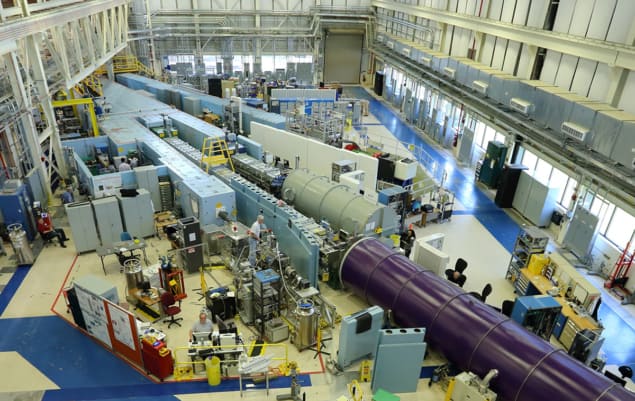Robert P Crease describes how news of a radiation leak at a US neutron facility was handled in today’s online, networked and locked-down world

On the morning of Wednesday 3 February 2021, the research reactor at the National Institute of Standards and Technology (NIST), just outside Washington, DC, was starting to come back online after routine maintenance. Shortly after 9 a.m., however, radiation monitors in the building detected above-normal background radioactivity, consisting of fission fragments from the ruptured cladding of a fuel element. The reactor automatically shut down.
NIST is one of the US’s leading metrology labs, located in Gaithersburg, Maryland, whose 60,000 or so inhabitants may not even know about the presence of a reactor in their midst. Although just half an hour’s drive from the White House, the NIST campus is in an ordinary residential area. However, the reactor’s long-term survival may depend on the local community – and its residents – being able to make a clear and accurate appraisal of its value and safety.
News of accidents at nuclear reactors, wherever they are in the world, often triggers uncertainty, fear and even panic
News of accidents at nuclear reactors, wherever they are in the world, often triggers uncertainty, fear and even panic. Whatever NIST did next to publicize the incident was therefore going to be highly risky for the lab, the reactor and the research community that depends on it. Commenting immediately, before much information was available, might make it appear as though the lab were in the dark. Holding off an announcement pending an investigation would invite accusations of a cover-up, and seem to open the possibility of worse news to follow.
Then and now
The Gaithersburg research reactor was built on farmland in 1967 by what was then known as the US National Bureau of Standards, which was renamed NIST in 1988. Now officially called the NIST Center for Neutron Research (NCNR), it’s used by some 3000 scientists each year and is still vitally important to the US neutron community. Indeed, the NCNR supports about half of all neutron-scattering work in the country. Any interruption in its operation, however brief, would be devastating for neutron research.
But how was NIST to handle the release of information about the incident? The messaging was critical. I immediately recalled how Brookhaven National Laboratory’s High Flux Beam Reactor was forced to shut down permanently in 1999 after tritium-containing water, of no environmental or health impact, leaked from its spent fuel pool. As it transpired, early in the evening on 3 February, NIST put a notice on its website, sent out the news on social media, and asked Gaithersburg city officials to help spread the word.
“We’ve just released a statement on today’s alert at the NIST Center for Neutron Research,” the lab tweeted that evening. “Health and safety of our staff and community is our top priority. No indications of elevated radiation levels outside the building.” This was followed a few minutes later by another tweet: “The public remains safe.”
Two days later, NIST posted a 500-word update on its website and via Twitter and Facebook, saying that, after taking a shower, members of staff who had been exposed to the radiation were cleared to go home. It also said that the Nuclear Regulatory Commission (NRC), which licenses and regulates the reactor, had declared the facility and the public safe.
The reactor, NIST reminded the public, had operated safely for 50 years and was a valuable national resource. Its notice also stressed the differences between the NCNR and power reactors, which typically run at more than 100 times the power of research reactors and are much different in size, scale, structure and operation.
A week after the incident, on 10 February, the lab held a virtual public town-hall meeting. Questions were allowed to be submitted by e-mail or via the meeting platform’s Q&A function, and voices and video were muted (questions could be asked anonymously). Around 240 people attended, and NIST’s acting director Jim Olthoff answered all questions. The lab put up the questions and responses on an updateable web page).
A week later, on 18 February, Rob Dimeo, director of NIST’s Center for
Neutron Research, held a virtual town-hall meeting for the neutron-user community. It was attended by around 300 people concerned with how long the reactor would be down, and how its closure would affect their research. Here, too, attendees were muted and questions submitted via e-mail and the platform’s Q&A, as well as by chat.
The virtual format, mandated by the COVID-19 lockdown, meant that the town-hall meetings could be quickly arranged and draw possibly more people than might otherwise have attended
Interestingly, the virtual format, mandated by the COVID-19 lockdown, meant that the meetings could be quickly arranged and draw possibly more people than might otherwise have attended. “The virtual environment allowed for a more measured interaction between NIST and members of the public,” said NRC public affairs officer Scott Burnell. “People were submitting questions via chat, not open mike, which kept the temperature of the room under control.”

What the storming of the US Capitol tells us about science
But the format was risky, as accepting questions only in writing and muting participants ran the danger of leaving them feeling indulged and patronized, spurring them to seek other forms of venting and information-spreading, which social media famously invites. So did NIST convey an accurate and transparent portrayal of the incident without condescension on the one hand or provoking unnecessary fears on the other? “It’s too early to draw conclusions,” Jennifer Huergo, NIST’s director of media relations, told me. “We did our best with the tools at hand.”
The critical point
Reactors are indispensable scientific instruments, which address national needs and would cost billions of dollars to replace, if indeed any government had the will to try. They are also lightning rods for political and social concerns. The future of neutron research depends not only on building and maintaining more neutron facilities, but also on understanding and addressing the concerns that they arouse. Paying attention to how episodes like the one at NIST play out is a first step.



